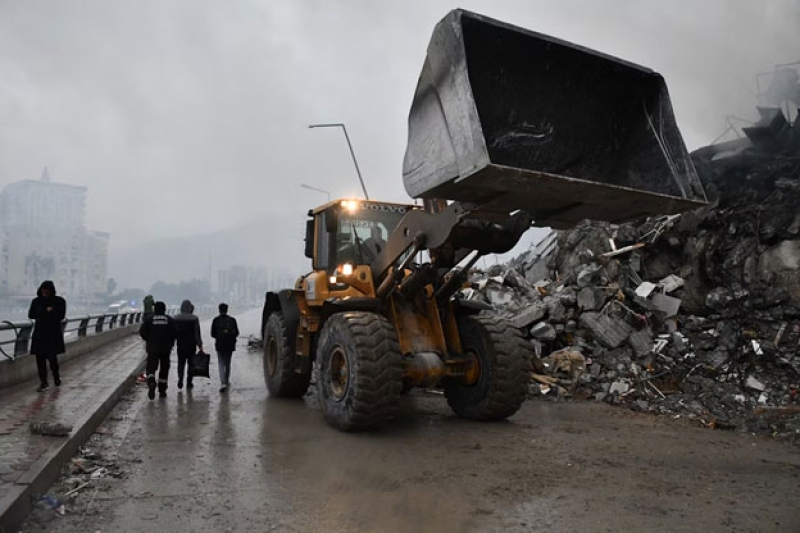- CA Yunus pays homage to Liberation War martyrs on Victory Day |
- Bangladesh capital market extends losing streak for second day |
- Bangladesh celebrates Victory Day Tuesday |
- 'Different govts presented history based on their own ideologies': JU VC |
Disaster Risk Reduction Pays Off, Says UN Report

Plow clears rubble in Hatay, Turkey after quake. Credit: Çağlar Oskay/Unsplash
Floods, earthquakes, and droughts are hitting global economies harder than ever. According to the Global Assessment Report on Disaster Risk Reduction, the cost of disasters is steadily increasing, with annual expenditures exceeding $2.3 trillion—over 2% of global GDP. If disaster costs were considered a national GDP, they would rank as the world’s seventh-largest economy.
This $2.3 trillion includes indirect and ecosystem-related impacts. Meanwhile, direct costs averaged $180–200 billion annually from 2001 to 2020, a 153% increase from the $70–80 billion average between 1970 and 2000.
The report stated, “A national debt of just $300 billion was enough to trigger the European sovereign debt crisis,” highlighting the growing threat disasters pose to global financial stability.
The report also found that economic resilience is directly linked to a nation’s ability to absorb disaster shocks. For instance, in 2023, North America lost $69.57 billion due to disasters, which only impacted 0.23% of its GDP. In contrast, Micronesia, an Oceanian region comprising 2,000 small islands, lost $4.3 billion—equivalent to 46.1% of its $1.43 billion GDP.
While developed countries can bounce back, developing nations with limited capital must choose between continued economic growth and rebuilding. But there’s hope through smart investment.
In Pakistan, recurring floods and storms threatened economic development. In response, the country invested in mangrove forests, which offer both environmental protection and economic returns. These forests serve as a natural barrier against storms, protecting industries that have grown around them.
According to the IUCN, Pakistan earned a 20-fold return on its mangrove investments. Mangroves not only act as a defense mechanism but also generate sustainable development by providing habitats for fish and animals, shielding coastlines, and storing three to four times more carbon than tropical forests.
Makkio Yashiro, UNEP's regional ecosystems coordinator, said:
“Mangroves are an important tool in the fight against climate change. They reduce atmospheric carbon and make financial sense. Restoring mangroves is five times more cost-effective than building grey infrastructure like flood walls.”
The UNEP also reported that every $1 invested in mangrove restoration yields $4 in benefits, confirming it as a no-loss investment.
The Three Harmful Cycles
Aromar Revi, Director of the Indian Institute for Human Settlements (IIHS), identified three recurring cycles linked to disaster vulnerability:
Rising debt and declining income. Many companies are underinsured, making them vulnerable to disaster-related disruptions and broader financial instability.
Decreased insurability, as noted by Theodora Antonakaki of the Bank of Greece. She warned that traditional risk transfer methods are no longer keeping pace with modern disaster risks.
Over-reliance on costly humanitarian aid, which Ronald Jackson, Head of UNDP's Disaster Risk Reduction team, said weakens resilience. He emphasized the need for disaster financing strategies, including budget tracking systems tailored to regional risks.
Success Stories: Pakistan and Japan
While many countries remain trapped in these damaging cycles, some—like Japan and Pakistan—are taking proactive steps through disaster risk reduction (DRR).
Japan, which frequently experiences tsunamis and earthquakes, has invested in seismic isolation bearings, which allow buildings to move horizontally during quakes, minimizing damage. For tsunamis, the country uses seawalls and coastal forests to absorb or deflect water.
The report argues that disasters themselves aren’t necessarily increasing in frequency or strength—but the cost of replacing lost infrastructure is skyrocketing. A significant factor is the lack of safe, resilient housing tailored to regional risks. By 2050, an estimated 1.2 billion additional people will be living in urban areas compared to 2020, making DRR-centric urban planning vital.
Research consistently shows that disaster losses far exceed prevention costs, making early action not only smart but economically essential.
UN Secretary-General António Guterres concluded:
“This report clearly shows that investing in disaster risk reduction saves money, saves lives, and lays the foundation for a safe and prosperous future for us all. I urge all leaders to heed that call.”

